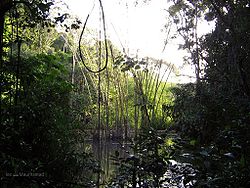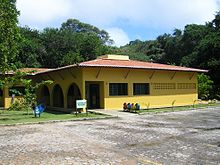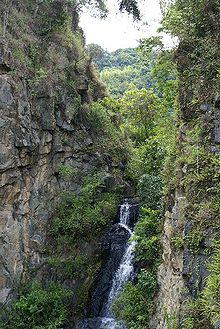- Atlantic Forest
-
Discovery Coast Atlantic Forest Reserves * UNESCO World Heritage Site
Virgin Mata Atlântica in PernambucoCountry Brazil Type Natural Criteria ix, x Reference 892 Region ** Latin America and the Caribbean Inscription history Inscription 1999 (23rd Session) * Name as inscribed on World Heritage List
** Region as classified by UNESCOThe Atlantic Forest (Portuguese: 'Mata Atlântica') is a region of tropical and subtropical moist forest, tropical dry forest, tropical savanna, semi deciduous forest and mangrove forests which extends along the Atlantic coast of Brazil from Rio Grande do Norte state in the north to Rio Grande do Sul state in the south, and inland as far as Paraguay and the Misiones Province of Argentina.
The Atlantic Forest region includes forests of several variations.
- The coastal restingas are low forests which grow on stabilized coastal dunes.
- The coastal forests, also known as Atlantic moist forests, are evergreen tropical forests with structures.
- Inland are the interior forests, also known as the Atlantic semi-deciduous forests, where many trees drop their leaves during the dry season.
- Further inland are the Atlantic dry forests, which form a transition between the arid Caatinga to the northeast and the Cerrado savannas to the east.
- Montane moist forests occur in the Serra do Mar and across the mountains and plateaus of southern Brazil, and are home to Araucaria and evergreen trees of the laurel (Lauraceae) and myrtle (Myrtaceae) families.
- Shrubby montane savannas occur at the highest elevations.
The Atlantic Forest is unusual in that it extends as a true tropical rainforest to latitudes as high as 24°S. This is because the trade winds produce precipitation throughout the southern winter. In fact, the northern Zona da Mata of northeastern Brazil receives much more rainfall between May and August than during the southern summer.
 The Dunas Park in Rio Grande do Norte is one of the largest units of conservation of atlantic forest in Brazil.
The Dunas Park in Rio Grande do Norte is one of the largest units of conservation of atlantic forest in Brazil.
The Atlantic Forest is now designated a World Biosphere Reserve, which contains a large number of highly endangered species including the well known marmosets, lion tamarins and woolly spider monkeys. It has been extensively cleared since colonial times, mainly for the farming of sugar cane and for urban settlements. The remnant is estimated to be less than 10% of the original and that is often broken into hilltop islands.
The Amazon Institute is active in reforestation efforts in the northeastern state of Pernambuco, Brazil. During 2007, Joao Milanez and Joanne Stanulonis have planted 5,500 new trees in the mountains commencing with Gravata, adding to the precious little, ancient forest left.
During glacial periods, however, the Atlantic Forest is known to have shrunk to extremely small refugia in highly sheltered gullies, with most of the land area more recently occupied by the characteristic Atlantic Forest being occupied by dry forest or even semi-desert. Some maps even suggest the forest actually survived in moist pockets well away from the coastline, where its endemic rainforest species mixed with much cooler-climate species. Unlike refugia for equatorial rainforests, the refuges for the Atlantic Forest have never been the product of detailed identification.
Ecoregions
 Virgin Mata Atlântica in Paraná.
Virgin Mata Atlântica in Paraná.
Tropical and subtropical moist broadleaf forests
- Araucaria moist forests
- Atlantic Coast restingas
- Bahia coastal forests
- Bahia interior forests
- Caatinga enclaves moist forests
- Paraná-Paraíba interior forests
- Pernambuco coastal forests
- Pernambuco interior forests
- Serra do Mar coastal forests
Tropical and subtropical dry broadleaf forests
Tropical and subtropical grasslands, savannas, and shrublands
Mangroves
- Bahia mangroves
- Ilha Grande mangroves
- Rio Piranhas mangroves
- Rio São Francisco mangroves
See also
External links
- Amazon Institute
- Atlantic Forest (Conservation International)
- Atlantic Forest Foundation, help preserves the Atlantic Forest
- Iracambi Atlantic Rainforest Research and Conservation Center
- Atlantic forest (World Wildlife Fund)
- Plant a Billion Trees in the Atlantic Forest
- Conservation significance of the Atlantic Forest
- Embassy of Brazil in London: Atlantic Forest
- FirstFlora
- The Nature Conservancy: Atlantic Forest (with photo)
- The Reforestation efforts of 2 individuals in Pernambuco Joanne Stanulonis and João Milanêz
- UNESCO: Discovery Coast Atlantic Forest Reserves
World Heritage Sites in Brazil North 

Northeast Brazilian Atlantic Islands: Fernando de Noronha and Atol das Rocas Reserves · Discovery Coast Atlantic Forest Reserves1 · Historic Centre of São Luís · Historic Centre of Salvador da Bahia · Historic Centre of the Town of Olinda · Serra da Capivara National Park
Central-West Brasília · Cerrado Protected Areas: Chapada dos Veadeiros and Emas National Park · Historic Centre of the Town of Goiás · Pantanal Conservation Area
Southeast Atlantic Forest South-East Reserves1 · Discovery Coast Atlantic Forest Reserves1 · Historic Centre of the Town of Diamantina · Historic Town of Ouro Preto · Sanctuary of Bom Jesus do Congonhas
South Atlantic Forest South-East Reserves1 · Iguaçu National Park · Jesuit Missions of the Guaranis2: Ruins of São Miguel das Missões
1 Shared with other region/s · 2 Shared with Argentina Regions and States of Brazil North Northeast Center-West Southeast South - Fernando de Noronha
- Rocas Atoll
- Saint Peter and Saint Paul
- Trindade and Martim Vaz
Categories:- Biodiversity hotspots
- Ecoregions of Brazil
- Forests of Brazil
- Tropical and subtropical moist broadleaf forests
- Geography of South America
- Geography of Brazil
- World Heritage Sites in Brazil
- Biosphere reserves of Brazil
- Neotropic
Wikimedia Foundation. 2010.
